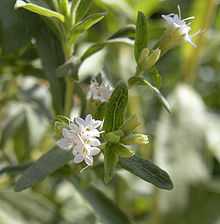Stevia rebaudiana
| Stevia rebaudiana | |
|---|---|
 | |
| Stevia rebaudiana flowers | |
| Scientific classification | |
| Domain: | Eukaryota |
| Kingdom: | Plantae |
| (unranked): | Angiosperms |
| (unranked): | Eudicots |
| (unranked): | Asterids |
| Order: | Asterales |
| Family: | Asteraceae |
| Tribe: | Eupatorieae |
| Genus: | Stevia |
| Species: | S. rebaudiana |
| Binomial name | |
| Stevia rebaudiana (Bertoni) Bertoni | |
Stevia rebaudiana is a plant species in the genus Stevia of the sunflower family (Asteraceae), commonly known as sweetleaf, sweet leaf, sugarleaf.
Stevia is widely grown for its sweet leaves, which are the source of sweetener products known generically as stevia and sold under various trade names. The active compounds are various steviol glycosides (mainly stevioside and rebaudioside), which have 250–300 times the sweetness of sugar.[1]
The leaves can be eaten fresh, or put in teas and foods.
History and use
The plant has been used for more than 1500 years by the Guaraní people of Brazil and Paraguay, who called it ka'a he'ê ("sweet herb"), to sweeten the local yerba mate tea, as medicine, and as a "sweet treat".[2]
In 1899, botanist Moisés Santiago Bertoni first described the plant as growing in eastern Paraguay, and observed its sweet taste.[3]

In 1931, chemists M. Bridel and R. Lavielle isolated the glycosides stevioside and rebaudioside that give the leaves their sweet taste.[4] The exact structure of the aglycone and the glycoside was published in 1955.
Cultivation
Stevia rebaudiana plants which are found in the wild in semiarid habitats ranging from grassland to mountain terrain, do produce seeds, but only a small percentage of the seeds germinate. Planting cloned stevia is a more effective method of reproduction.
Stevia rebaudiana has been grown on an experimental basis in Ontario, Canada since 1987 to determine the feasibility of commercial cultivation.[5] Duke University researchers developed a strategic plan to assist farmers and exporters in Paraguay to compete in the global market for stevia.[6]
Today, Stevia rebaudiana is cultivated and used to sweeten food elsewhere in East Asia including China (since 1984), Korea, Taiwan, Thailand, and Malaysia. It can also be found in Saint Kitts and Nevis, Brazil, Colombia, Peru, Paraguay, Uruguay, and Israel.[7]
References
- ↑ Raji Akintunde Abdullateef, Mohamad Osman (1 January 2012). "Studies on effects of pruning on vegetative traits in Stevia rebaudiana Bertoni (Compositae)". International Journal of Biology 4 (1). doi:10.5539/ijb.v4n1p146.
- ↑ Misra, H.; Soni, M.; Silawat, N.; Mehta, D.; Mehta, B. K.; Jain, D. C. (Apr 2011). "Antidiabetic activity of medium-polar extract from the leaves of Stevia rebaudiana Bert. (Bertoni) on alloxan-induced diabetic rats". J Pharm Bioallied Sci 3 (2): 242–8. doi:10.4103/0975-7406.80779. PMC 3103919. PMID 21687353.
- ↑ Bertoni, Moisés Santiago (1899). Revista de Agronomia de l'Assomption 1: 35. Missing or empty
|title=(help) - ↑ Bridel, M.; Lavielle, R. (1931). "Sur le principe sucre des feuilles de kaa-he-e (stevia rebaundiana B)". Academie des Sciences Paris Comptes Rendus (Parts 192): 1123–5.
- ↑ Todd J (2010). "The Cultivation of Stevia, "Nature's Sweetener"". Ontario Ministry of Agriculture and Food. Retrieved 20 March 2014.
- ↑ Bamber, P; Fernandez-Stark, K (2012). "Strengthening the competitiveness of the stevia value chain in Paraguay" (PDF). Duke University Center on Globalization, Governance and Competitiveness. Retrieved 20 March 2014.
- ↑ Jones, Georgia (September 2006). "Stevia". NebGuide: University of Nebraska–Lincoln Institute of Agriculture and Natural Resources. Retrieved 4 May 2007.